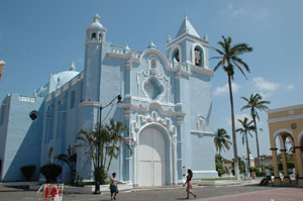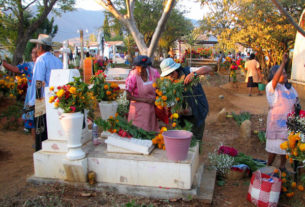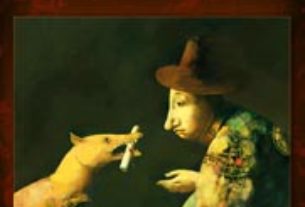In January 1992, looking for the roots of the musical form called son jarocho, I made a pilgrimage to the river port town of Tlacotalpan, Veracruz. At dawn, as I boarded the southbound bus from the port of Veracruz, I was as excited as a child on Christmas morning. Tlacotalpan — the self-proclaimed heart of the music and dance that has been my passion for 20 years. Wow!
Forty-five minutes after leaving Veracruz we were driving down a narrow strip of land. The sun rose over the Gulf of Mexico on our left. On our right was the huge Laguna de Alvarado, which is the mouth of the Rio Papaloapan (Nahuatl – Aztec – for butterflies). Soon we passed the charming port of Alvarado where the Rio Papaloapan dumps into the Gulf. Within a few kilometers the turn off for Tlacotalpan/Cosamaloapan appeared. That road followed along the wide, placid Rio de Mariposas (Spanish for Papaloapan). At 7:00 a.m. I was dropped off in the flattest but prettiest of towns.

Tlacotalpan, after a series of disastrous fires, had been rebuilt and came of age during the Porfiriato (the thirty years before 1910). The one and two story neoclassic buildings are painted intense shades – emerald and lime green, pale pink, rosa mexicana, lavender, purple, violet, blue, turquoise, yellow and melon – no insipid, unimaginative white in this town. Contrasted with the riot of color was the town’s tranquility and peacefulness at that early hour. It was a peacefulness that permeated my entire day.
Except for the road that paralleled the river, traffic was minimal and the population continued along its lugubrious way in the tropical heat. I wandered the town all day. First I visited the churches on the parque (park) and then took in the Museo Salvador Fernado – a museum in an old house containing artifacts of interest from the city’s past. I ate spicy, rich seafood at one of the stands along the river, lazily watching the fishermen bring in their catch. I meandered over to the Casa de Cultura, which is also the museum of the great Mexican composer Agustín Lara — Tlacotalpan’s favorite son.
In my near dream-like state I got lost innumerable times (the river appeared and disappeared in the most amazing way). I perused the regional tienda de artesanias on the parque for folk art and handicrafts and of course bought several tapes of the local music. In the excellent restaurant of the Hotel Doña LaLa, I ate a leisurely dinner and got to know the owner. With true Mexican hospitality, he invited me to his mother’s birthday party that night. I was clearly the only tourist around. It had been a charming and restful day in this provincial, laid-back, and out of the way town. However, I was soon to discover that contrary to my first impression, the entire town, every person, every building, every business, every house and every family was busy preparing — preparing physically, mentally, and spiritually. Preparing because in five days the Feria or Fair would start.
50 weeks out of the year Tlacotalpan sits in its torpid tropical slumber, but starting late January and running for two weeks it celebrates the Fiesta de la Candelaria. For most of these two weeks the Feria (fair) is made up of a carnival, bailes tropicales (salsa dances), and a very large tianguis (temporary market). Then – in stark contrast to its normal tranquility — on January 31st through February 2nd the town explodes into a religious and secular frenzy, its streets stuffed with true believers and joyful revelers.
The afternoon of January 31 kicks off with the Cabalgata (cavalcade). This is a parade of equestrians, dressed in what is recognized as the symbolic traje (costume) of the Jarochos (folks who live in southern Veracruz). The men dress in white with a red paliacate (bandana), and the typical sombreo de cuatro piedras (hat of four rocks or indentations), The women wear flowing white dresses, black aprons and rebozos (shawls) with ribbons and flowers in their hair. During the next three days there will be other parades including the “ Mojiganga” (a procession of giant figures). There will be regattas on the river, bailes, masses, various presentations in the parque, and lots of drinking of Toritos de Cacahuates (liquor made from peanuts). In the whirl of activity there are three events that stand out; el Encuentro de Jareneros, el Corrido de Toros , and el Paseo de la Virgin .
Starting on the night of January 31st in la Plaza de Doña Marta, jareneros (musicians who play the traditional music from southern Veracruz, called Son Jarocho) gather for the largest Encuentro and Fandango of the year. The Encuentro (encounter), is a staged event where groups from many of the small towns and ranchos present the multitude of musical styles that come from the sub-zones of the region. Along with the musicians, the Decimistas come to present their work. Decimas are poems of ten line stanzas that are declared (dramatically spoken with the accompaniment of Son Jarocho music). This form is closely related to a form in Cuba and in fact, southern Veracruz was a favored destination of immigration for Cubanos. Decimas often proclaim the greatness of Veracruz and the beauty of its women, but the majority are picaresque comments on everyday life. Along about 11 p.m. the action shifts to the parque where a Fandango (dance done to Son Jarocho) gets started. Here one can watch the most talented dancers from the region tearing it up until 8,9, or even 10 a.m. The Encuentro and Fandangos span all three nights.
El Corrido de Torros is just that, the Running of the Bulls. As February first approaches businesses start putting-up bamboo fences in front of their establishments. The bulls in Tlacotalpan are free to run more or less where they will, controlled only by vaqueros (cowboys). As a result, they are likely to shoot down any street at any time, jump up on the sidewalks, and have even been known to enter houses – why a door would be open is a question unto itself. One year, carefully avoiding the center of town, some friends and I were walking down a side street and were about to cross one of the major avenues when two vaqueros galloped by warning us of an approaching bull. As we were on a somewhat narrow side street, we felt backing up a short distance would be sufficient protection. In a timely manner we were doing just that, when who should decide to hang a left at our corner but the bull. I’ve never jumped on top of a car so fast in my life!
We were not exactly thrilled to see that bull and he probably less so us – in retrospect I am sure he was just looking for some peace and quiet. During the late morning he had been herded with two companions to the riverbank across from the town. There, totally against his will, he was driven – with much rope slapping, yelling, pulling, pushing and tail twisting — by vaqueros into the river and forced to swim the great width of the Papaloapan. As he entered the river he had been greeted by boatloads of folks who had come out to accompany him on his journey. Upon arriving at the opposite bank, another set of vaqueros busily set about driving him up onto the shore. Now however, leaving the river was totally against the bull’s wishes as he was being driven into an excited crowd of hundreds of people who were waiting for him on the wide boulevard above.
A bull, upon mounting the bank, immediately becomes very dangerous. He doesn’t know where he is or where to go and all the people yelling, throwing things and trying to jump on his back confuse him. He learns very quickly that by charging he can get a little respect and some space and so he starts doing this consistently. Every year, as a result of the bulls trying to protect themselves, people are seriously hurt and sometimes killed. The bulls too are seriously injured and they are always killed. For the bulls, death may come as a blessing after such an incredibly tough day. The city fathers talk about trying to control the situation but nothing has been done yet. My advise for anyone interested in “ El Corrido” is that they attempt to obtain seating on a private balcony or roof or that they procure a boat and watch from afar.
The Papaloapan is a huge river that has been fairly tranquil since the building of the Aleman Dam. As the conduit of great quantities of water – draining both las sierras and la cuenca (mountains and river basin) – it has in the past habitually overflowed its banks causing deadly flooding. El Paseo de la Virgen de la Candelaria is a supplication for protection against this event. February 2nd is the birthday of the Virgen de la Candelaria. On this morning, a mass is held starting at dawn. Around 6 a.m. a mariachi and the jaraneros (who have been playing at the Fandango all night) enter the church for the playing of Las Mañanitas (the traditional Mexican Birthday song) and La Llorona (The Crying Woman). A little later the Virgen is carried in procession through the center of town and down to the malecon (walkway along the river) where a barge awaits her.
There a crush of people tries to board the barge in order to take the paseo (passage) along the river with the Virgin. My first year, having innocently joined the procession, I found myself caught in the surge to board. My friend managed his way on, but I was forced face to face with a very fierce police officer. Finding myself in the proverbial “immovable object/irresistible surge” quandary, I quickly decided that a tourist card wouldn’t be much protection and as gracefully as possible extricated myself. Many folks rent boats from the local fishermen, even bringing musicians along to serenade the Virgin on her voyage up and down the river. Those who do not manage to acquire a boat, line the shore to watch the procession.
Tlacotalpan is a relatively small town and at the time of the Feria, with folks coming from all over the region, its population expands exponentially. The town sports only two modest hotels (La Reforma and Doña LaLa) and their regular clients book them up the year before. One can get a hotel in the towns of Alvarado or Cosamaloapan which are fairly close. In doing this however, one would give up what may be the greatest thing about the Candelaria. This is the opportunity of a lifetime for the casual visitor to Mexico. Because there are so few hotels, just about everyone opens their house up and the traveler who normally wouldn’t get a chance to be up close and personal with a Mexican family gets just that opportunity.
I had gone to Tlacotalpan several days before the Candelaria to check out the housing situation. I went to the Hotel Doña LaLa to inquire about lodging and was directed by the staff to a very nice middle-class family. A friend and I stayed in a private room at the grandmother’s house. While this house had only cold water (it’s the tropics you know) we were invited to the families house to use hot water if we preferred. We had the run of the house and secure parking for the car. We met all the neighbors, were invited to lunch one day, and went out with the family on their boat for the running of the bulls. And best of all, now I have friends in Tlacotalpan.
I chose to ask about lodging at the Doña LaLa, but the palacio (city hall), any business, cab drivers, and in fact just about anyone on the street will know of a room. While I went early, and I believe that this is the best idea, there is usually some sort of room available throughout the Feria. Keep in mind that on the three principle days the selection will be slim. I procured my room, left a deposit, and found all in readiness when I returned ten days later. Be sure you state clearly that you want a private room. If you don’t, you might find yourself sleeping with the cousins who just dropped by.
Expect that you will share a bathroom and if hot water is an issue, ask about it. Be sure to look at the room first. The room where we stayed did not have a door but a lace curtain. The idea of a curtain was no problem for us, but we wanted something a little heavier and we were accommodated. You will probably not get a key, so be clear with folks about what kinds of hours you’ll keep – probably late ones like everyone else’s. Meals are not normally part of the package, but there are several good restaurants so you won’t starve and you can get a latte in el parque. Prices are negotiable, our room cost thirty dollars a day. This was not bad, perhaps a little high — but considering all we got, probably a good deal.
One small point about money. Tlacotalpan has one bank and it does not cash travelers checks, rarely changes dollars and during the three days of the Candelaria it is closed. The Hotel Doña LaLa will sometimes change dollars but the rates are insulting. Better to come prepared than drive the rutted road to Cosamaloapan to bank.
If you’re going to visit Veracruz, do yourself a favor and go to Tlacotalpan — go for the tranquility, go for the excitement, go for the colors, for the music, the sea food, the warmth, the processions, the bulls, the dancing, and be sure to go for the chilaquiles verdes at the Restaurant Doña Lala — I never miss a chance.


